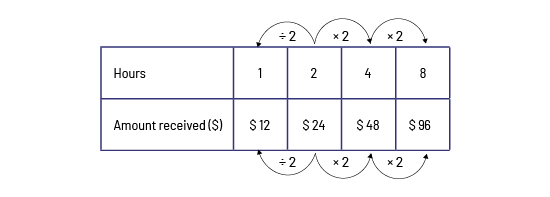B2.8 Show simple multiplicative relationships involving whole-number rates, using a variety of tools and drawings.
Skill: Representing Multiplicative Relationships Involving Rates
The multiplicative and divisibility relationships between two numbers are relationships based on multiplication and division respectively.
For example, there is a multiplicative relationship between 3 and 15 since 15 is a multiple of 3, and also a divisibility relationship since 15 is divisible by 3.
Source: translated from Guide d'enseignement efficace des mathématiques de la 4e à la 6e année, Numération et sens du nombre, Fascicule 1, Nombres naturels, p. 55
Example
I buy 2 bags of rice for $10.
I can represent this rate in different ways:
- Using words - 2 bags of rice cost $10.
- Like a division - \(2\; bags\;of\;rice \div $10\).
- As a fraction - \(\frac{{2\;{\rm{\;bags\;\; of\;\; rice}}}}{{\$\;10 }}\).
Using the multiplicative relationship, I can determine the rate of other quantities of rice.

For 4 bags of rice, the cost will be $20. 4 bags is twice as much as 2, so the price is twice as much as $10.

For 10 bags of rice, the cost will be $50. 10 bags is 5 times more than 2, so the price is 5 times more than $10.
I can also determine the unit rate, the cost for 1 bag of rice, using division.

For 1 bag of rice, the cost will be $5. 1 bag is half as much as 2, so the price is half as much as $10.
Rates are part of our daily lives. Students can be led to find different examples related to measurements (for example, I run 12 km per hour, the electric bike goes 35 km per hour, and so on) and costs (for example, $3 for 12 apples, $15/hour, and so on).
Students can solve problems representing multiplicative relationships involving rates using familiar contexts.
Example
If you get $24 for 2 hours of work, how much money do you get for 4 hours?
The student should therefore observe that 4 hours is double or twice as much as 2 hours so the amount of money will also double, so $48. These relationships can be represented in a ratio table showing multiplicative, not additive, relationships.

Knowledge: Multiplicative Relationship
A multiplicative relationship is a relationship between two numbers based on multiplication. Rates represent comparisons based on multiplication and division.
Source: translated from En avant les maths, 4e, CM, Nombres , p. 3.
Knowledge: Rate
A rate describes the relationship between two quantities expressed with different units (for example, bananas per dollar, granola bars per child or kilometres per hour).
Source: translated from En avant les maths, 4e, CM, Nombres , p. 2.
